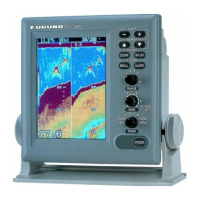
Do you have a question about the Furuno FCV-582L and is the answer not in the manual?
| Display Type | LCD |
|---|---|
| Resolution | 640 x 480 pixels |
| Frequency | 50/200 kHz |
| Power Output | 600 W |
| Operating Temperature | -15°C to +55°C |
| Power Supply | 12/24 V DC |
Warnings regarding electrical shock, opening the unit, and potential fire hazards.
Guidelines for safe operation, including heater placement and fuse usage.
Details about the warning label and the characteristics of the TFT LCD display.
Introduction to the FCV-582L and a brief on Furuno's reputation.
Highlights of the sounder's primary functions and design benefits.
Diagram detailing the User Menu options and their hierarchy.
Diagram outlining the System Menu 1, 2, and 3 options.
Illustration showing how to access the Optional Mode menu.
Visual representation of the FCV-582L system components and connections.
Explanation of how the sounder determines depth and identifies underwater objects.
Description of how the sounder creates its visual display from scan lines.
Detailed explanation of each control on the FCV-582L display unit.
Explanation of various indicators and markers displayed on the sounder screen.
Procedures for powering the unit, adjusting display settings, and choosing display modes.
Selecting display range and adjusting receiver sensitivity (gain).
Using automatic modes and controlling the speed of the display scan.
Erasing weak echoes and using the Variable Range Marker (VRM) for depth measurement.
Activating the A-scope display and navigating the User Menu for settings.
Methods for reducing interference, suppressing noise, and customizing display colors.
Setting up and managing the unit's various alarm functions.
Utilizing the white marker and fine-tuning gain for dual frequency operation.
Instructions on how to access and navigate the Optional Mode menu.
Instructions for accessing and navigating System Menu 1, 2, and 3.
Detailed explanation of settings within System Menu 1, 2, and 3.
Using the demonstration mode and adjusting the bottom echo level detection.
Adjusting Time Varied Gain (TVG) and echo offset for signal compensation.
Understanding the zero line and how fish school echoes are represented.
Interpreting bottom echoes for density and hardness determination.
Identifying and understanding display artifacts caused by surface noise and aeration.
Procedures for regular equipment checks and cleaning the display unit.
Caring for the transducer and safely replacing the fuse.
Table of common problems and their potential solutions.
Performing ROM/RAM checks and testing display colors.
Procedure for restoring factory default settings by clearing the memory.
Technical details on transmit frequency, power, display type, and modes.
Specifications for display ranges, range shift, and user configurable settings.
Specifications for data input/output, power requirements, and environmental ratings.